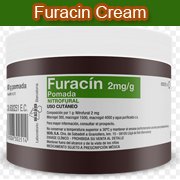
How to Use Furacin?
Furacin Cream is administered topically. Apply directly with a sterile tongue–depressor or other spatula (of wood or stainless steel only). Alternatively, melt the cream in a beaker at a little above body temperature and pour gently onto the lesion.
Furacin may also be applied on a gauze dressing. For extensively burned areas, large strips of sterile gauze impregnated with Furacin Cream are often preferred. Bandages may be prevented from absorbing the cream by covering the impregnated gauze with an impermeable layer such as jaconet or gauze saturated with petroleum jelly. If bandages stick, remove them by saturating with sterile saline. Dressings may be left undisturbed on burns, cuts and wounds for 7 to 10 days. Treatment Furacin should be stopped when the infection has cleared.
Furacin Cream – Cautions
Use of Furacin Cream occasionally allows overgrowth of non-susceptible organisms including fungi and Pseudomonas. If this occurs or if irritation, sensitization or super-infection develops, treatment with Furacin Cream should be stopped and the lesion irrigated with water or saline solution to remove the medication. Appropriate treatment should then be started.
Furacin Cream should be used with caution in patients with known or suspected renal impairment. The polyethylene glycol can be absorbed through denuded skin, cannot then be excreted normally by the compromised kidney and may lead to symptoms of progressive renal impairment.
Furacin Side Effects
Sensitization to Furacin occasionally occurs and treatment should be stopped if pruritus, irritation, erythema, local edema or vesicles develop. Such allergic reactions should be treated symptomatically.
Furacin during Pregnancy and Lactation
Oral nitrofurazone at 30 times the human dose has been shown to have an embryocidal effect in rabbits. There have been insufficient studies in pregnant women to indicate any hazard to the fetus. Nevertheless, Furacin Cream should be used during pregnancy only if the benefit justifies any risk to the fetus.
Nitrofurazone in high dosage has been shown to produce mammary tumors in rats. The relevance of this to topical use in humans, is unknown. It is also not known whether Furacin (nitrofurazone) is excreted in human milk. Because many drugs are so excreted and because of nitrofurazone’s association with carcinogenicity, the physician must decide whether the mother should stop feeding her infant or whether he should discontinue Furacin Cream, taking into account the importance of the drug to his patient.
Furacin Cream is a yellow, semi-solid, opaque to translucent cream with a characteristic glycol odor. It contains 0.2% w/w nitrofurazone in a water- soluble polyethylene glycol base. How Does Furacin Look Like?
Leave A Comment